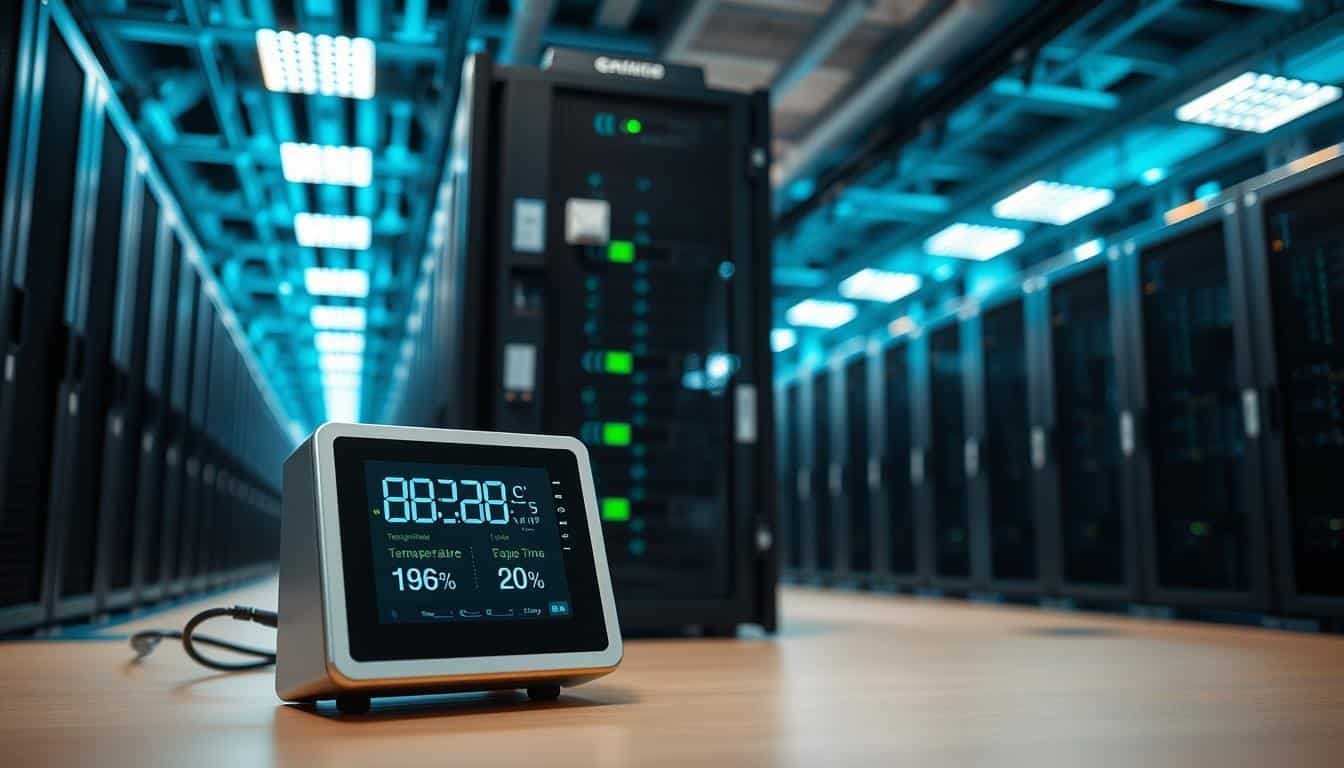Your data center’s reliability and efficiency are key in today’s world. You must follow IDCW (Infrastructure Data Center Workload) rules for environmental monitoring. This keeps your data center running smoothly, reduces downtime, and meets industry standards.
Good environmental monitoring lets you spot problems early, protecting your critical infrastructure. By watching temperature, humidity, airflow, and water leaks, you can improve your data center’s environment and ensure your IT equipment works as it should.
Key Takeaways
- IDCW requirements are essential for maintaining optimal data center performance and compliance.
- Comprehensive environmental monitoring helps you identify and address potential issues before they cause downtime or equipment damage.
- Tracking critical parameters like temperature, humidity, airflow, and water leaks is crucial for data center optimization.
- Proactive environmental management enhances the reliability and efficiency of your data center operations.
- Adhering to IDCW standards ensures your data center complies with industry best practices.
Understanding Data Center Environmental Monitoring Fundamentals
Keeping your data center’s environment just right is key to its success. Knowing what to monitor and how these factors affect your data center is crucial. This knowledge helps your data center stay strong and thrive over time.
Key Environmental Parameters to Monitor
In a data center, you should watch temperature monitoring, humidity monitoring, and airflow monitoring closely. These factors greatly impact your IT equipment’s performance, energy use, and lifespan.
Impact of Environmental Factors on Data Center Performance
Changes in temperature, humidity, and airflow can affect your data center. Too much heat can cause your equipment to overheat and fail early. High humidity can lead to moisture and corrosion, damaging your systems.
Real-time Monitoring vs. Periodic Checks
Having a solid environmental monitoring plan is vital. While regular checks are helpful, real-time monitoring lets you catch and fix problems as they happen. This approach keeps your data center running smoothly, reduces downtime, and extends your IT equipment’s life.
| Parameter | Ideal Range | Impact on Data Center Performance |
|---|---|---|
| Temperature | 18°C to 27°C (64°F to 81°F) | Excessive heat can lead to equipment overheating and premature failures. |
| Humidity | 40% to 60% relative humidity | High humidity levels can cause condensation and corrosion, compromising system integrity. |
| Airflow | Adequate airflow to maintain proper cooling | Insufficient airflow can result in hot spots and inefficient cooling, leading to equipment failures. |
“Proactive environmental monitoring is the key to ensuring the long-term reliability and efficiency of your data center.”
IDCW Requirements for Data Center Environmental Monitoring
Keeping your data center running smoothly is key. Following IDCW (Infrastructure, Data, Connectivity, and Workload) rules for environmental monitoring is vital. These guidelines help keep your IT systems safe and efficient. They prevent failures or disruptions from environmental issues.
One important IDCW rule is to monitor and analyze environmental factors in real time. This includes tracking temperature, humidity, airflow, and more. These factors can affect your equipment’s performance and lifespan.
- Implementing robust temperature monitoring systems to maintain optimal cold aisle and hot aisle temperatures
- Deploying humidity control and monitoring solutions to prevent static buildup and equipment failure
- Optimizing airflow management through strategic placement of fans, vents, and other airflow management tools
- Utilizing water leak detection and prevention systems to mitigate the risk of water damage
By following these IDCW rules for critical environment monitoring, your data center will run at its best. This reduces the chance of expensive downtime. It also keeps your IT infrastructure healthy for the long term.
“Proactive monitoring and management of data center environmental factors is essential for maintaining the reliability and performance of your mission-critical IT systems.”
Critical Temperature Monitoring Systems and Standards
In the fast-paced world of data centers, keeping the temperature just right is key. It ensures your systems run smoothly and reliably. Good temperature monitoring systems are essential for this. They let you track and manage the environment in real time.
Hot Aisle vs. Cold Aisle Temperature Management
Data centers use a hot aisle-cold aisle setup to cool things down. By watching the temperature in these areas, you can improve airflow. This keeps your important equipment safe from overheating.
Temperature Threshold Settings and Alerts
Setting the right temperature limits and having a strong alert system are crucial. Precision cooling lets you adjust these settings. This keeps your data center at the perfect temperature for top performance.
ASHRAE Temperature Guidelines Implementation
The American Society of Heating, Refrigerating and Air-Conditioning Engineers (ASHRAE) has guidelines for data center temperatures. Following these ASHRAE guidelines helps keep your data center efficient and healthy. It supports your precision cooling efforts well.
| ASHRAE Temperature Guidelines | Recommended Range |
|---|---|
| Inlet Temperature | 18°C (64.4°F) to 27°C (80.6°F) |
| Dew Point Temperature | 5.5°C (41.9°F) to 15°C (59°F) |
| Relative Humidity | 20% to 80% |
Following these temperature monitoring tips helps your data center run at its best. It keeps your critical systems reliable and performing well.
Humidity Control and Monitoring Solutions
In the world of data centers, keeping humidity levels right is key. It helps your equipment work well and last longer. Good humidity monitoring and control are important for your data center’s health.
Managing humidity in data centers is tricky. Too dry air can cause static, while too much moisture can damage equipment. Advanced humidity monitoring systems keep humidity levels in check, following ASHRAE guidelines.
- Hygrometers: These sensors measure air humidity accurately, giving real-time data for control systems.
- Humidifiers and Dehumidifiers: These devices work together to keep humidity just right, adjusting as needed.
- Integrated Monitoring and Control: Critical environment monitoring systems use sensors and smart controls to keep humidity perfect, alerting staff to any issues.
By focusing on humidity monitoring and using strong control solutions, data center managers can protect their critical environment. This ensures your equipment works well and reliably.
“Proper humidity control is essential for maintaining the health and longevity of data center equipment.”
Advanced Airflow Management and Monitoring Techniques
Data centers aim for better energy use and performance. Managing airflow is crucial. We’ll look at new ways to manage airflow, tools for monitoring, and how to check pressure differences. These are key for better cooling and running data centers smoothly.
Airflow Optimization Strategies
Good airflow management keeps temperatures right and stops hot spots. Some effective strategies include:
- Placing servers and racks right to let air flow freely
- Using accessories like blanking panels and air dams
- Setting up containment systems to keep hot and cold air apart
- Adjusting fan speeds and CRAC unit settings as needed
Monitoring Tools and Technologies
Airflow monitoring is vital for spotting issues and improving cooling. Tools like anemometers, airflow sensors, and thermal cameras give detailed views of airflow and temperatures.
These advanced tools help us understand rack cooling better. This knowledge leads to better efficiency and reliability in your data center.
Pressure Differential Monitoring
Checking pressure differences between hot and cold aisles is key. The right balance ensures cool air reaches servers and hot air is removed.
Monitoring pressure differences in real-time bits of help adjust fans and CRAC units. This keeps airflow optimal and avoids cooling problems.
“Proper airflow management is the foundation of an energy-efficient and reliable data center. By leveraging advanced monitoring techniques, you can unlock significant improvements in cooling performance and operational resilience.”
Water Leak Detection and Prevention Systems
In a data center, water leaks are a big threat to equipment and infrastructure. It’s crucial to have systems that detect and prevent leaks. These systems use the latest tech to spot even tiny leaks, helping you act fast to avoid big problems.
Spotting leaks early is vital. Sensors placed around your data center watch for moisture. If they find a leak, they alert your team right away. This quick alert lets you stop the leak and protect your important equipment.
Modern leak prevention systems do more than just detect leaks. They also have features like automatic shut-off valves and leak containment systems. These help keep your data center safe and running smoothly, without interruptions.
FAQ
What are the key environmental parameters that should be monitored in a data center?
In a data center, it’s important to watch temperature, humidity, airflow, water leaks, and power use. Keeping an eye on these factors helps your data center run smoothly and meet standards.
How do environmental factors impact data center performance?
Things like temperature, humidity, and airflow can really affect your data center’s gear. Keeping these factors in balance is key to avoiding failures, saving energy, and following the rules.
What is the difference between real-time monitoring and periodic checks?
Real-time monitoring means always watching and recording your data center’s environment. This lets you spot and fix problems right away. Periodic checks are manual or scheduled, which might not be as quick or thorough.
What are the IDCW requirements for data center environmental monitoring?
IDCW gives guidelines for keeping your data center running well. It covers things like temperature, humidity, airflow, spotting water leaks, and watching power use.
How can I effectively manage hot and cold aisle temperatures in my data center?
To manage aisle temperatures, use a system that tracks and keeps temperatures right. Place sensors in aisles, set alerts, and adjust cooling systems to meet ASHRAE’s guidelines.
What are the key considerations for implementing ASHRAE temperature guidelines in my data center?
When using ASHRAE’s temperature rules, think about your equipment, layout, and energy goals. Working with HVAC experts and following ASHRAE’s ranges can save energy and improve performance.
How can I effectively monitor and control humidity in my data center?
Keeping humidity levels right is key to avoiding damage and ensuring your data center works well. Use a system that tracks humidity, alerts you when it’s off, and adjusts your systems as needed.
What are some advanced airflow management and monitoring techniques I can use in my data center?
For better airflow, try optimizing rack and tile placement, using containment systems, and airflow tools. These methods help find and fix airflow issues, improve cooling, and keep the right pressure in your data center.
How can I effectively detect and prevent water leaks in my data center?
A good water leak detection and prevention system is vital. Install sensors, link them to your monitoring system, and have shut-off valves ready to act fast in case of leaks.
How can I monitor power consumption and optimize energy efficiency in my data center?
To keep an eye on power use and save energy, install sensors and track power at different levels. Use this data to fine-tune your cooling, workload, and energy plans.



